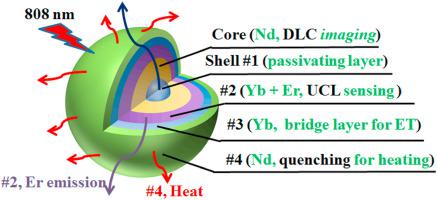Journal of Luminescence ( IF 3.3 ) Pub Date : 2021-02-06 , DOI: 10.1016/j.jlumin.2021.117960 W.B. Dai , H. Li , Y. Chen , Y.M. Fan , F. Shen

|
The simultaneous realization of real-time thermal sensing at physiological temperature range and fluorescence imaging during photothermal therapy (PTT) via single-component biocompatible nanocomposite could furthest avoid collateral damage and enhance phototherapeutic effect, which, up to now, is of great interest and still in a formidable challenge. Under near-infrared (NIR) light irradiation, Nd3+-doped nanoparticles (NPs) have emerged as candidates with outstanding properties such as down-conversion emissions in biological window (BW) and capable of light-to-heat conversion. However, these two properties associated with Nd3+ doping concentrations induce opposite changing trend and difficult to combine within one single nanocomposite. In this work, for breaking through the obstacles, core/shell NaLuF4:1%Nd@NaLuF4@NaLuF4:15%Yb,3%Er@NaLuF4:15%Yb@NaLuF4:85%Nd 808 nm light-triggered co-enhancement up/down-conversion luminescence (UCL/DCL) nanocomposite was purposely designed with efficient heating, thermal sensing and fluorescence imaging concurrently. The core emits high quantum yield (QY) DCL in BW while the outermost layer could convert the absorbed photon into thermal energy and also transfer a fraction of energy inwards to internal layer with exciting the UCL (Nd→Yb→Er) for thermal sensing via thermally coupled levels 2H11/2/4S3/2 of Er using the fluorescence intensity ratio (FIR) method. The simultaneously enhanced UCL/DCL and thermal effect in the engineered nanocomposite are satisfactorily realized due to suppressing the interionic quenching owing to the inert two layers NaLuF4 and NaLuF4:15%Yb. Such smart designed nanocomposite has potential application on PTT-based noninvasive cancer therapy.
中文翻译:

核/壳纳米复合材料的多功能上/下转换发光,用于自监测加热和荧光成像
通过单组分生物相容性纳米复合材料同时实现生理温度范围的实时热感测和光热疗法(PTT)期间的荧光成像,可以最大程度地避免附带损害并增强光疗效果,到目前为止,这一点一直很受关注,并且仍然面临巨大挑战 在近红外(NIR)光照射下,Nd 3+掺杂的纳米颗粒(NPs)已成为具有出色特性的候选物,例如生物窗口(BW)中的下转换发射并且能够进行光热转换。但是,这两个属性与Nd 3+有关掺杂浓度引起相反的变化趋势,并且难以在一个单一的纳米复合物中结合。在这项工作中,为了突破障碍,核/壳NaLuF 4:1%Nd @ NaLuF 4 @NaLuF 4:15%Yb,3%Er @ NaLuF 4:15%Yb @ NaLuF 4:85%Nd 808 nm光线触发共增强上/下转换发光(UCL / DCL)纳米复合材料是专门设计的,同时具有高效的加热,热传感和荧光成像功能。磁芯在BW中发出高量子产率(QY)DCL,而最外层则可以通过激发UCL(Nd→Yb→Er)将吸收的光子转换成热能,并将一部分能量向内传输到内层,从而通过使用荧光强度比(FIR)方法对Er进行2 H 11/2 / 4 S 3/2的热耦合能级。通过抑制由于惰性两层NaLuF 4和NaLuF 4:15%Yb引起的离子猝灭,可以令人满意地实现工程纳米复合材料中同时增强的UCL / DCL和热效应。这种智能设计的纳米复合材料在基于PTT的非侵入性癌症治疗中具有潜在的应用。











































 京公网安备 11010802027423号
京公网安备 11010802027423号